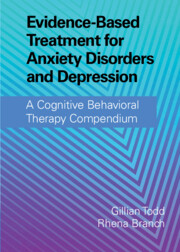 Evidence-Based Treatment for Anxiety Disorders and Depression
Evidence-Based Treatment for Anxiety Disorders and Depression Evidence-Based Treatment for Contamination and Checking
from Part Three - Cognitive Behavioral Therapy for Obsessive-Compulsive Disorder and Associated Disorders
Published online by Cambridge University Press: 06 January 2022
Contamination concerns and checking remain two of the most prevalent forms of presentation in OCD, reported by 25–50% of sufferers, with checking the most common compulsion. Since they cover a broad spectrum of concerns and complexity, the assessment and treatment of contamination and checking carries its own challenges for the therapist. This chapter explores the nature of contamination and checking concerns and provides an overview of recent research. Practical advice and guidance will guide the therapist from initial assessment to formulation and the development of an effective treatment protocol. The prevalence of covert safety-seeking behaviors such as rumination is discussed as a frequent obstacle in treatment. It advocates a move away from graded hierarchies for exposure and considers what effective exposure should consist of, encouraging the use of creativity and playfulness. A range of both common and less common presentations is used to illustrate key concepts.
To save this book to your Kindle, first ensure [email protected] is added to your Approved Personal Document E-mail List under your Personal Document Settings on the Manage Your Content and Devices page of your Amazon account. Then enter the ‘name’ part of your Kindle email address below. Find out more about saving to your Kindle.
Note you can select to save to either the @free.kindle.com or @kindle.com variations. ‘@free.kindle.com’ emails are free but can only be saved to your device when it is connected to wi-fi. ‘@kindle.com’ emails can be delivered even when you are not connected to wi-fi, but note that service fees apply.
Find out more about the Kindle Personal Document Service.
To save content items to your account, please confirm that you agree to abide by our usage policies. If this is the first time you use this feature, you will be asked to authorise Cambridge Core to connect with your account. Find out more about saving content to Dropbox.
To save content items to your account, please confirm that you agree to abide by our usage policies. If this is the first time you use this feature, you will be asked to authorise Cambridge Core to connect with your account. Find out more about saving content to Google Drive.